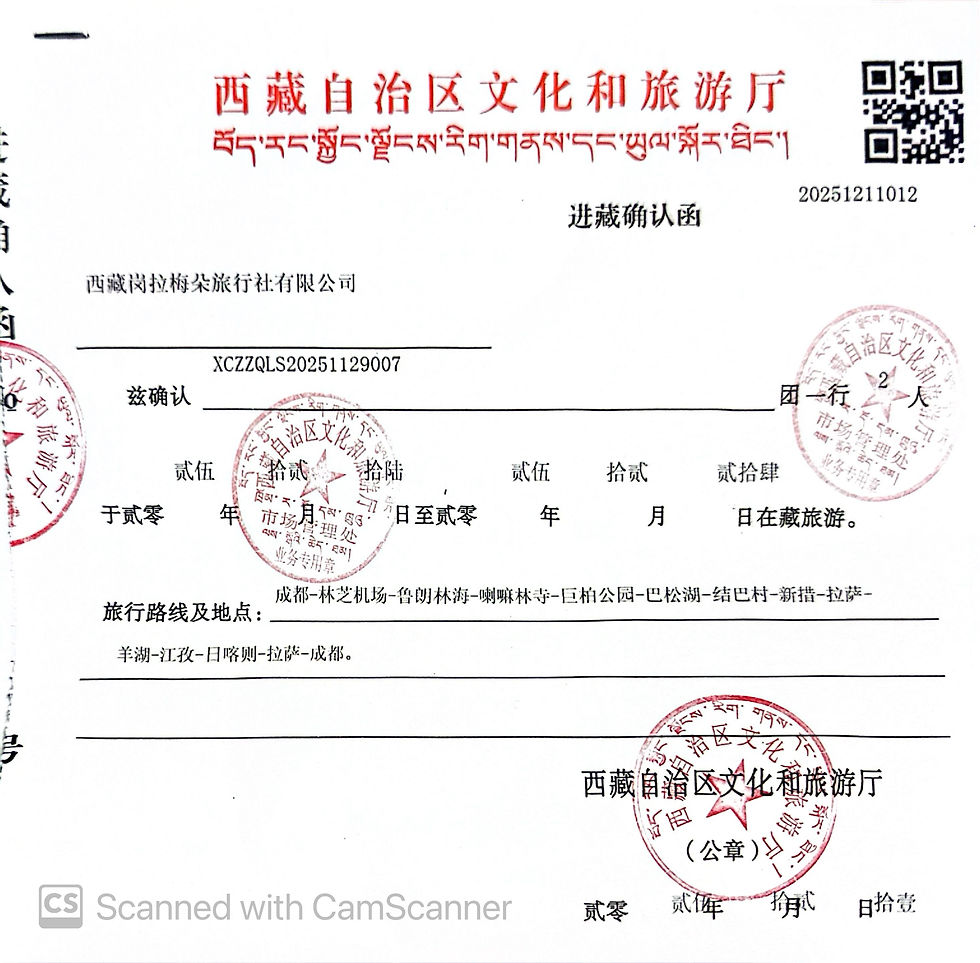Tibet Travel Information: A Complete Guide for First-Time Visitors
- tibetantours
- May 31
- 4 min read
Tibet, known as the Roof of the World, is one of the most fascinating and spiritually enriching destinations on Earth. Nestled high in the Himalayas, this remote region of China offers breathtaking landscapes, sacred monasteries, colorful prayer flags fluttering in the wind, and warm-hearted people deeply rooted in their traditions.
Traveling to Tibet is a unique experience—but it also requires careful planning. In this blog, we’ll cover everything you need to know before you go: permits, best times to visit, what to pack, altitude sickness, money matters, and more.
🛂 1. Travel Permits: What You Need to Enter Tibet
Foreign travelers are not allowed to enter Tibet independently. You must book a tour with a registered Tibetan travel agency, which will help arrange the required documents:
• Tibet Travel Permit (TTP): Required for entry into Tibet, issued by the Tibet Tourism Bureau.
• Alien’s Travel Permit (ATP): Needed for visiting regions outside Lhasa, like Shigatse and Everest Base Camp.
• Military Permit: Required for sensitive areas like Mount Kailash or the Nyingchi region.
Important: You must first obtain a Chinese visa, then send a scanned copy of your visa and passport to the travel agency to apply for the Tibet permits.
🕰️ 2. Best Time to Visit Tibet
Tibet is accessible year-round, but the best seasons for travel are:
• April to June: Mild temperatures and clear skies.
• September to October: Excellent visibility for mountain views, fewer tourists.
• July to August: Lush and green, but occasional rain (good for cultural festivals).
• November to March: Off-season with fewer tourists, cold but peaceful (some areas closed).
🏔️ 3. Acclimatization and Altitude Sickness
Most of Tibet lies above 3,500 meters (11,500 ft). Altitude sickness is common during the first few days.
Tips to Manage Altitude:
• Rest on the first day in Lhasa.
• Drink plenty of water.
• Avoid alcohol and smoking.
• Consider taking Diamox (consult your doctor first).
• Ascend gradually if possible (e.g. taking the train from Xining).
Symptoms may include headaches, shortness of breath, dizziness, and fatigue. These usually subside after 1–2 days of acclimatization.
🎒 4. What to Pack for Your Tibet Trip
Tibet’s weather can be unpredictable. Prepare for cold mornings, sunny days, and chilly nights.
Packing Essentials:
• Layered clothing (T-shirt, fleece, windproof jacket)
• Comfortable walking shoes or hiking boots
• Sunglasses and sunscreen (UV is very strong at high altitude)
• Lip balm and moisturizer
• Hat and gloves (especially for Everest region)
• Personal medications and a basic first-aid kit
• Thermos or reusable water bottle
💰 5. Money and Payments in Tibet
• Currency: Chinese Yuan (RMB)
• Cash: Bring enough cash for rural areas and small towns.
• Cards: Credit cards are accepted only in large hotels in Lhasa.
• Digital Payment: WeChat Pay and Alipay are commonly used in Lhasa and big towns, but setup requires a Chinese bank account or linked international card.
• ATMs: Available in Lhasa and Shigatse but may not work with foreign cards.
🚗 6. Transportation in Tibet
• Getting to Tibet: Most travelers fly to Lhasa from cities like Chengdu, Xining, or Kathmandu. The Qinghai-Tibet Railway from Xining is a scenic and gradual way to acclimatize.
• Within Tibet: Tours include a driver and guide with private vehicles. There are no public buses between major destinations for tourists.
🛏️ 7. Accommodation in Tibet
• Lhasa, Shigatse, Tseadang , Nyingchi, and Ngari city are Good options from 3- to 5-star hotels.
• Smaller towns (Tingri, Namtso): 2- to 3-star hotels or guesthouses.
• Remote areas (Mount Kailash, Everest): Basic guesthouses with shared bathrooms and limited heating.
🍜 8. Food and Dining in Tibet
Tibetan cuisine is simple but hearty:
• Momos: Steamed dumplings with meat or vegetables.
• Tsampa: Roasted barley flour mixed with butter tea.
• Thukpa: Noodle soup with vegetables or meat.
• Yak meat and butter tea: Common in local homes.
Vegetarian options are available in most restaurants. Bring snacks for long drives or treks.
🙏 9. Culture and Etiquette in Tibet
Tibet is deeply spiritual, and travelers should respect local customs and traditions.
Do’s:
• Walk clockwise around stupas and monasteries.
• Remove your hat when entering temples.
• Greet locals with a smile or nod.
Don’ts:
• Do not touch people’s heads.
• Avoid pointing at religious objects.
• Do not photograph inside temples unless permitted.
📸 10. Photography in Tibet
Tibet is a photographer’s paradise with stunning landscapes, vibrant prayer flags, and expressive faces.
• Ask before taking portraits.
• Avoid drones in sensitive or restricted areas.
• Best light: early morning or late afternoon.

🧭 Final Thoughts
A trip to Tibet is more than a journey—it’s a spiritual and personal awakening. From majestic Himalayan peaks to the peaceful chants of monks in ancient monasteries, every moment offers a connection to something deeper.
With proper planning and an open heart, your Tibet adventure will leave you with lifelong memories.
✨ Need Help Planning Your Trip?
As a local Tibetan travel agency, we’re here to help! We provide customized tours, Tibet permit arrangements, trekking experiences, and cultural immersion packages.
Contact us today to start planning your unforgettable journey to the Roof of the World!






Comments